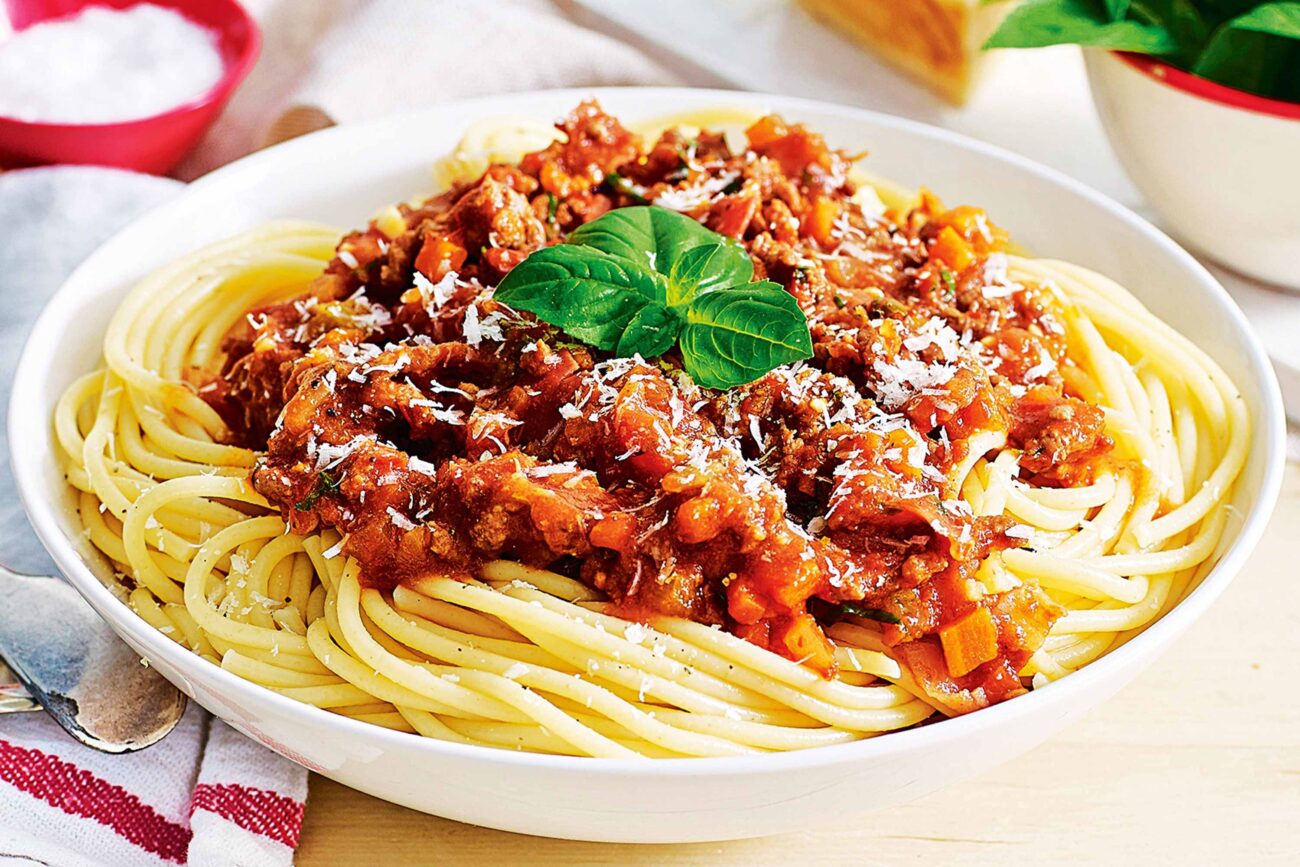Imagine twirling forkfuls of al dente spaghetti coated in a rich, savory sauce that’s simmered to perfection, bursting with layers of flavor that transport you straight to the heart of Italy. That’s the magic of spaghetti Bolognese – a timeless classic that’s not just a meal, but an experience.Spaghetti Bolognese Recipe Whether you’re a novice cook craving an easy weeknight dinner or a seasoned chef seeking to elevate your Italian repertoire, this comprehensive guide will unlock the secrets to creating the ultimate spaghetti Bolognese. Spaghetti Bolognese Recipe Packed with step-by-step instructions, expert tips, and mouthwatering variations, you’ll discover why this dish has captivated food lovers worldwide for centuries.
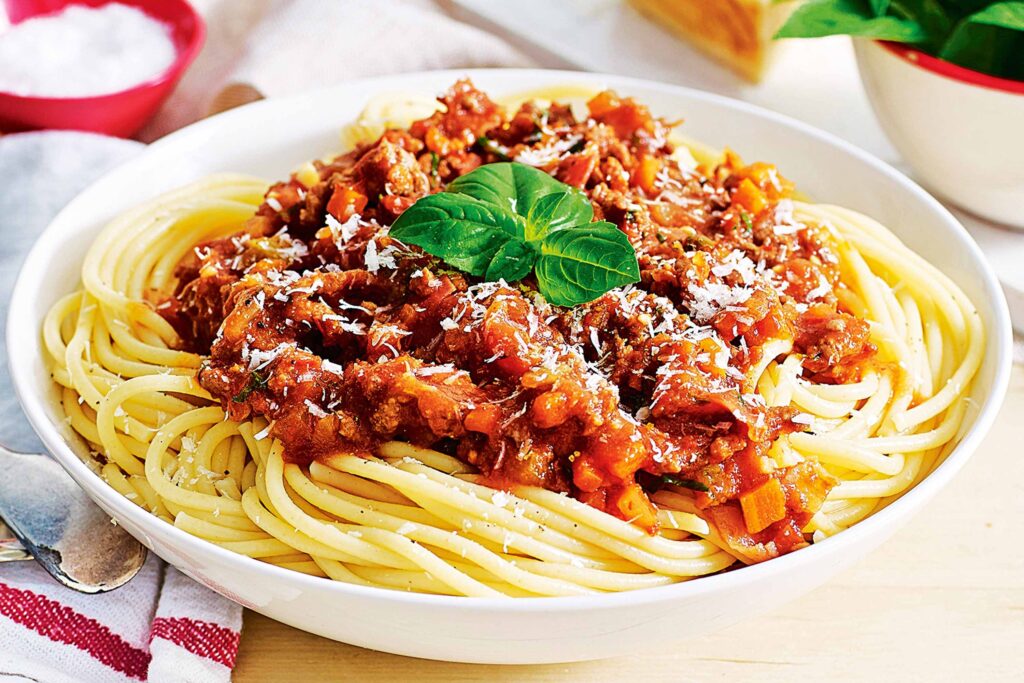
Spaghetti Bolognese Recipe In this epic article, we’ll dive deep into the history, ingredients, preparation, and more, ensuring your next pasta night is nothing short of extraordinary.Spaghetti Bolognese Recipe Ready to transform simple pantry staples into a culinary masterpiece? Let’s get started!
The Captivating History Behind Spaghetti Bolognese: From Bologna’s Streets to Global Fame
Spaghetti Bolognese Recipe Spaghetti Bolognese, often lovingly called “spa lob” in many households, has a story as rich and layered as its sauce.Spaghetti Bolognese Recipe Contrary to popular belief, this beloved dish isn’t exactly what Italians in Bologna would recognize as traditional.Spaghetti Bolognese Recipe Let’s unravel the fascinating origins and evolution that make it an enduring favorite.
The roots of Bolognese sauce,Spaghetti Bolognese Recipe or raga allay Bolognese, trace back to the late 18th century in Iola, near Bologna.Spaghetti Bolognese Recipe The earliest documented recipe appears in a cookbook by Pellegrino Artois in 1891, describing a meat-based rag served with pasta. However, Artois’s version used mancheron and focused on veal, pancetta, and broth – no tomatoes in sight! This early iteration drew from French ragout influences,Spaghetti Bolognese Recipe evolving into the slow-cooked marvel we know today.
By the 20th century, as Italian immigrants spread across the globe, the dish adapted. In the United States and Britain,Spaghetti Bolognese Recipe it merged with tomato-heavy Neapolitan styles, birthing “spaghetti Bolognese.” Interestingly, authentic Bolognese raga is traditionally paired with tagliatelle, not spaghetti, as the wider noodles better hold the thick sauce.Spaghetti Bolognese Recipe The Italian Academy of Cuisine even registered an official recipe in 1982 with the Bologna Chamber of Commerce, emphasizing beef, pork, soffits (onion, celery, carrot), white wine, milk, and minimal tomato.
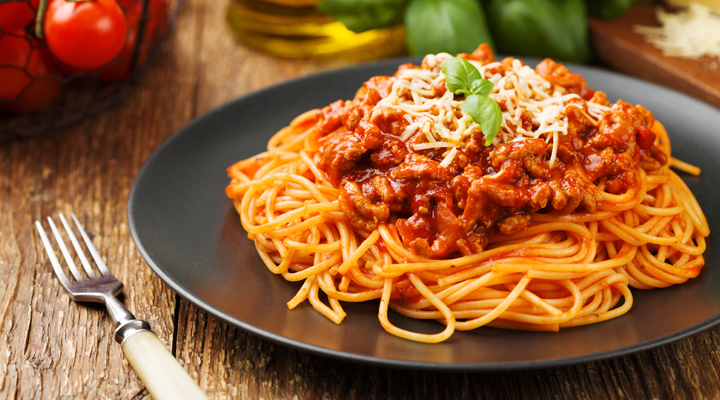
Common misconceptions abound: Many think it’s loaded with garlic, herbs, or spices, but true ragù relies on quality meat and slow simmering for depth.Spaghetti Bolognese Recipe Outside Italy, it’s often tomato-dominant, resembling a meaty marinara.Spaghetti Bolognese Recipe Yet, in Bologna, it’s a subtle, meat-forward sauce that’s simmered for hours.
This evolution highlights how cultural exchanges shape cuisine. For more on Italian pasta history, check our internal guide on best Italian pasta recipes. Externally,Spaghetti Bolognese Recipe explore the full story on Wikipedia’s Bolognese sauce page.
Delving deeper, the 19th-century version by Artusi included optional additions like dried mushrooms or truffles for luxury. Post-World War II,Spaghetti Bolognese Recipe as tomatoes became staples, the sauce gained its reddish hue.Spaghetti Bolognese Recipe Today, variations flourish – from American twists with ground turkey to vegetarian lentil-based options – proving its adaptability.
Why does this history matter? Understanding the origins empowers you to craft an authentic version while experimenting confidently. It’s not just food; it’s heritage on a plate.
Essential Ingredients: Building Blocks for an Unforgettable Bolognese Sauce
The secret to a showstopping spaghetti Bolognese lies in premium, fresh ingredients. Skip the shortcuts – quality shines through in every bite. Here’s a breakdown of what you’ll need, why each matters, and tips for sourcing the best.
Core Meat Components
- Ground Beef (300g): Opt for 80/20 lean-to-fat ratio for juiciness. It provides the hearty base.
- Ground Pork (250g): Adds sweetness and tenderness. Traditional recipes blend beef and pork for balance.
- Pancetta (150g): Italian cured pork belly infuses smoky depth. Substitute bacon if needed, but pancetta is authentic.
Vegetable Soffritto Trio
- Onion (1 medium): Finely chopped for subtle sweetness.
- Carrot (1 large): Diced to add natural sugar and color.
- Celery (1 stalk): Provides aromatic crunch and balances flavors.
This mirepoix-like base is non-negotiable – it builds complexity during sweating.
Liquid Elements for Richness
- White Wine (100ml): Dry varieties like Pinot Grigio deglaze and add acidity.
- Milk (100ml): Tenderizes meat and mellows tomatoes – a surprising but essential step.
- Tomato Paste (50g) or Puree (300g): Concentrated for umami without overpowering.
- Beef Stock (optional, 200ml): Enhances depth if simmering longer.
Seasonings and Finishing Touches
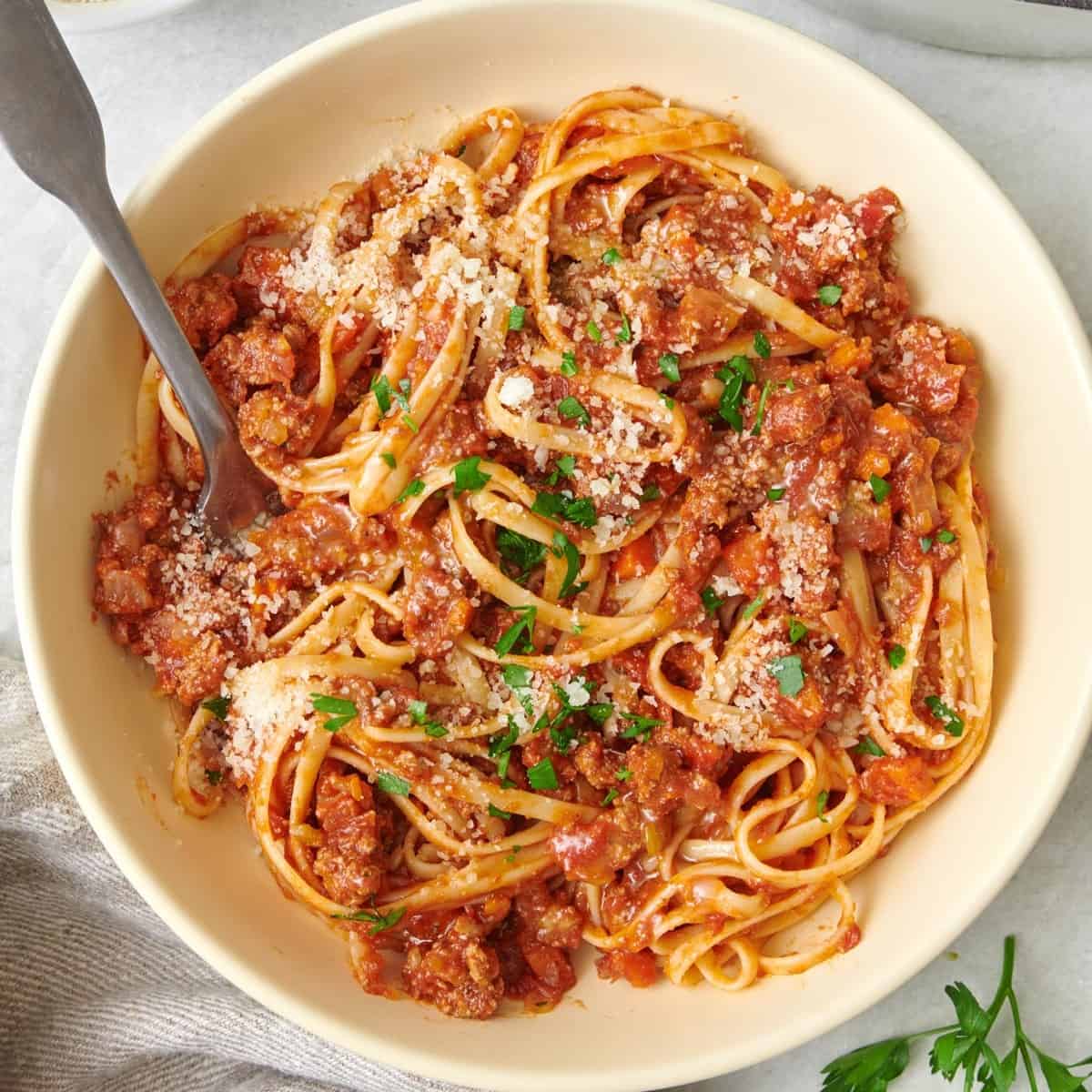
- Butter (50g): For sautéing and richness.
- Salt, Pepper, and Nutmeg (pinch): Subtle spices elevate without dominating.
- Parmesan Cheese (for serving): Freshly grated for that irresistible finish.
Pro tip: Source organic veggies and grass-fed meat for superior taste. For gluten-free twists, pair with alternative pastas – see our gluten-free Italian dishes section.
Expanding on selections: Ground beef from local butchers ensures freshness, while heirloom tomatoes amplify sauce vibrancy. Avoid pre-ground spices; fresh-grated nutmeg transforms the dish.
Step-by-Step Instructions: Crafting Your Perfect Spaghetti Bolognese
Ready to dive in? This foolproof recipe serves 4-6 and takes about 3-4 hours for authentic slow-cooking, but the results are worth it. Follow these steps for restaurant-quality results at home.
Preparation Phase
- Chop the Soffritto: Finely dice onion, carrot, and celery. This “holy trinity” is the flavor foundation.
- Prep the Meats: Cube pancetta and mix ground beef and pork.
Cooking the Sauce
- Sauté Pancetta: In a heavy pot, heat olive oil and cook pancetta until crispy (5 mins).
- Add Veggies: Stir in soffritto, cooking gently until soft (5-7 mins). Avoid browning.
- Brown the Meat: Crumble in beef and pork, stirring until no pink remains (10-15 mins). Let it sizzle in its fat for crisp bits.
- Deglaze with Wine: Pour in white wine, simmering until reduced.
- Incorporate Milk: Add milk, letting it absorb to tenderize meat.
- Tomato Time: Stir in tomato paste/puree, then simmer low for 2-3 hours. Stir occasionally; add stock if thickening too much.
Pasta and Assembly
- Cook Spaghetti: Boil in salted water until al dente (8-10 mins). Reserve pasta water.
- Combine: Toss pasta with sauce, adding pasta water for silkiness. Serve with grated Parmesan and basil.
Detailed notes: Simmering low and slow melds flavors – rush it, and you’ll miss the magic. For one-pot wonders, try our easy pasta recipes.
Troubleshooting: If sauce separates, whisk in butter. For thicker texture, uncover during final simmer.
Unlocking the full potential of spaghetti Bolognese requires insider secrets. These powerhouse tips will turn good into great.
- Slow Simmer Supreme: Patience is key – 3+ hours develops unmatched depth.
- Meat Quality Matters: Mix beef and pork for balance; add veal for luxury.
- Acid Balance: Wine cuts richness; a splash of vinegar if needed.
- Pasta Perfection: Cook al dente and finish in sauce for better adhesion.
- Make-Ahead Magic: Sauce tastes better day two – refrigerate up to 3 days or freeze.
Common mistakes: Overloading tomatoes or herbs dilutes authenticity. For storage, portion and reheat gently.
Advanced hacks: Infuse with porcini mushrooms for earthy notes, or use a pressure cooker for faster results (but sacrifice some tradition).
Link to our kitchen hacks guide for more.
Delicious Variations: Reinventing Spaghetti Bolognese for Every Palate
Bored of the classic? These innovative twists keep things exciting while honoring the original.
Vegetarian Bolognese
Swap meat for lentils or mushrooms. Sauté finely chopped portobellos with soffritto, add tomato and simmer. Nutty and satisfying!
Turkey Bolognese
Use ground turkey for leaner fare. It absorbs flavors beautifully – ideal for health-conscious eaters.
Vegan Version
Lentils, walnuts, and eggplant mimic meat texture. Use plant-based milk and stock.
Spicy Kick
Add chili flakes or Calabrian peppers for heat.
Seafood Fusion
Incorporate shrimp or clams for a coastal twist – pair with white wine.
Each variation maintains the essence while adapting. For more, see vegetarian Italian recipes.
External inspiration: Try BBC’s next-level version.
Nutritional Powerhouse: Health Benefits of Spaghetti Bolognese Revealed
Don’t dismiss this as indulgent – spaghetti Bolognese packs surprising nutritional punch when balanced.
A typical serving (about 2 cups) delivers around 650 calories, with 43g carbs, 29g protein, and 18g fat. Protein from meat supports muscle repair, while veggies provide fiber for digestion (3-4g per serving).
Tomatoes offer lycopene, an antioxidant fighting inflammation. Carrots and celery add vitamins A and K for eye and bone health. Whole-grain pasta boosts fiber, aiding blood sugar control.
Moderation key: Opt for lean meats to cut saturated fats. Overall, it’s a balanced meal covering carbs, proteins, and veggies.
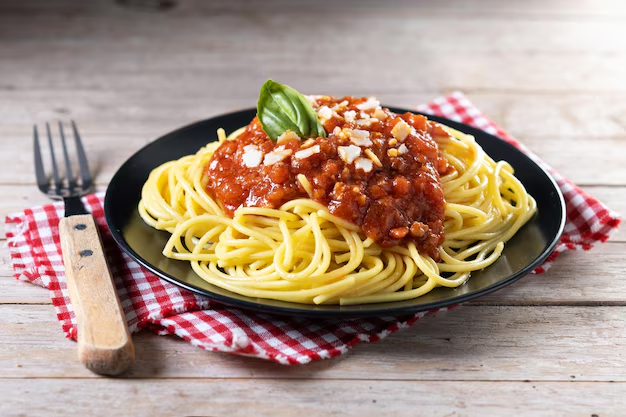
For full breakdowns, visit nutrition facts sites.
Perfect Pairings: Wines That Elevate Your Spaghetti Bolognese Experience
No Bolognese feast is complete without the right wine. These pairings amplify flavors for an unforgettable meal.
- Chianti Classico: Medium-bodied with cherry notes, cuts through richness.
- Sangiovese: Robust tannins match meaty sauce.
- Lambrusco: Sparkling red from Emilia-Romagna – traditional and refreshing.
- For Whites: Chardonnay for creamy twists.
Pro tip: Room temperature reds enhance aromas. Explore our wine pairing guide.
Frequently Asked Questions: Your Bolognese Queries Answered
Is Spaghetti Bolognese Authentic Italian?
Not strictly – true ragù pairs with tagliatelle, but it’s globally adored.
Can I Make It Ahead?
Yes! Flavors intensify overnight.
What’s the Difference from Meat Sauce?
Bolognese is milk-infused and less tomato-heavy.
